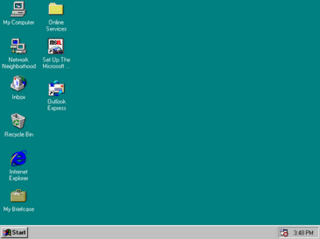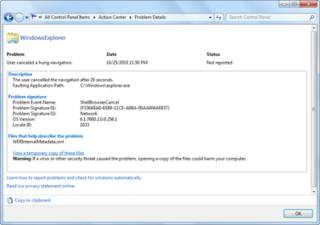
A flash drive is a data storage device that includes flash memory with an integrated USB interface. A typical USB drive is removable, rewritable, and smaller than an optical disc, and usually weighs less than 30 g (1 oz). Since first offered for sale in late 2000, the storage capacities of USB drives range from 8 megabytes to 256 gigabytes (GB), 512 GB and 1 terabyte (TB). As of 2023, 2 TB flash drives were the largest currently in production. Some allow up to 100,000 write/erase cycles, depending on the exact type of memory chip used, and are thought to physically last between 10 and 100 years under normal circumstances.

Windows 9x is a generic term referring to a line of discontinued Microsoft Windows operating systems from 1995 to 2000, which were based on the Windows 95 kernel and its underlying foundation of MS-DOS, both of which were updated in subsequent versions. The first version in the 9x series was Windows 95, which was succeeded by Windows 98 and then Windows Me, which was the third and last version of Windows on the 9x line, until the series was superseded by Windows XP.
Installation of a computer program, is the act of making the program ready for execution. Installation refers to the particular configuration of software or hardware with a view to making it usable with the computer. A soft or digital copy of the piece of software (program) is needed to install it. There are different processes of installing a piece of software (program). Because the process varies for each program and each computer, programs often come with an installer, a specialised program responsible for doing whatever is needed for the installation. Installation may be part of a larger software deployment process.
A human interface device (HID) is a type of computer device usually used by humans that takes input from or provides output to humans.

The USB mass storage device class is a set of computing communications protocols, specifically a USB Device Class, defined by the USB Implementers Forum that makes a USB device accessible to a host computing device and enables file transfers between the host and the USB device. To a host, the USB device acts as an external hard drive; the protocol set interfaces with a number of storage devices.

NDISwrapper is a free software driver wrapper that enables the use of Windows XP network device drivers on Linux operating systems. NDISwrapper works by implementing the Windows kernel and NDIS APIs and dynamically linking Windows network drivers to this implementation. As a result, it only works on systems based on the instruction set architectures supported by Windows, namely IA-32 and x86-64.
As the next version of Windows NT after Windows 2000, as well as the successor to Windows Me, Windows XP introduced many new features but it also removed some others.

The Apple–Intel architecture, or Mactel, is an unofficial name used for Macintosh personal computers developed and manufactured by Apple Inc. that use Intel x86 processors, rather than the PowerPC and Motorola 68000 ("68k") series processors used in their predecessors or the ARM-based Apple silicon SoCs used in their successors. As Apple changed the architecture of its products, they changed the firmware from the Open Firmware used on PowerPC-based Macs to the Intel-designed Extensible Firmware Interface (EFI). With the change in processor architecture to x86, Macs gained the ability to boot into x86-native operating systems, while Intel VT-x brought near-native virtualization with macOS as the host OS.
In computing, the USB human interface device class is a part of the USB specification for computer peripherals: it specifies a device class for human interface devices such as keyboards, mice, touchscreen, game controllers and alphanumeric display devices.

A live USB is a portable USB-attached external data storage device containing a full operating system that can be booted from. The term is reminiscent of USB flash drives but may encompass an external hard disk drive or solid-state drive, though they may be referred to as "live HDD" and "live SSD" respectively. They are the evolutionary next step after live CDs, but with the added benefit of writable storage, allowing customizations to the booted operating system. Live USBs can be used in embedded systems for system administration, data recovery, or test driving, and can persistently save settings and install software packages on the USB device.
MojoPac was an application virtualization product from RingCube Technologies. MojoPac turns any USB 2.0 storage device into a portable computing environment. The term "MojoPac" is used by the company to refer to the software application, the virtualized environment running inside this software, and the USB storage device that contains the software and relevant applications. MojoPac supports popular applications such as Firefox and Microsoft Office, and it is also high performance enough to run popular PC Games such as World of Warcraft, Minecraft and Half-Life 2.
A Bluetooth stack is software that is an implementation of the Bluetooth protocol stack.

Windows Error Reporting (WER) is a crash reporting technology introduced by Microsoft with Windows XP and included in later Windows versions and Windows Mobile 5.0 and 6.0. Not to be confused with the Dr. Watson debugging tool which left the memory dump on the user's local machine, Windows Error Reporting collects and offers to send post-error debug information using the Internet to Microsoft when an application crashes or stops responding on a user's desktop. No data is sent without the user's consent. When a crash dump reaches the Microsoft server, it is analyzed, and information about a solution is sent back to the user if available. Solutions are served using Windows Error Reporting Responses. Windows Error Reporting runs as a Windows service. Kinshuman Kinshumann is the original architect of WER. WER was also included in the Association for Computing Machinery (ACM) hall of fame for its impact on the computing industry.

Software remastering is software development that recreates system software and applications while incorporating customizations, with the intent that it is copied and run elsewhere for "off-label" usage. The term comes from remastering in media production, where it is similarly distinguished from mere copying.
Windows Vista has many significant new features compared with previous Microsoft Windows versions, covering most aspects of the operating system.
Windows Vista contains a range of new technologies and features that are intended to help network administrators and power users better manage their systems. Notable changes include a complete replacement of both the Windows Setup and the Windows startup processes, completely rewritten deployment mechanisms, new diagnostic and health monitoring tools such as random access memory diagnostic program, support for per-application Remote Desktop sessions, a completely new Task Scheduler, and a range of new Group Policy settings covering many of the features new to Windows Vista. Subsystem for UNIX Applications, which provides a POSIX-compatible environment is also introduced.
Windows Rally is a set of technologies from Microsoft intended to simplify the setup and maintenance of wired and wireless network-connected devices. They aim to increase reliability and security of connectivity for users who connect the devices to the Internet or to computers running Microsoft Windows. These technologies provide control of network quality of service (QoS) and diagnostics for data sharing, communications, and entertainment. Windows Rally technologies provide provisioning for the following devices:

IEEE 1394 is an interface standard for a serial bus for high-speed communications and isochronous real-time data transfer. It was developed in the late 1980s and early 1990s by Apple in cooperation with a number of companies, primarily Sony and Panasonic. It is most commonly known by the name FireWire (Apple), though other brand names exist such as i.LINK (Sony), and Lynx.
The transition from Windows 7 to Windows 8 introduced a number of new features across various aspects of the operating system. These include a greater focus on optimizing the operating system for touchscreen-based devices and cloud computing.
User-Mode Driver Framework (UMDF) is a device-driver development platform first introduced with Microsoft's Windows Vista operating system, and is also available for Windows XP. It facilitates the creation of drivers for certain classes of devices.








